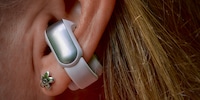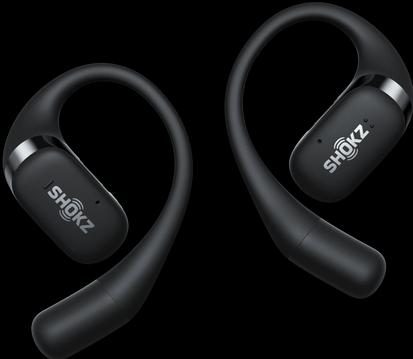

Shokz Open Fit: trying to tick too many boxes
Open-ear headphones are designed to provide a great audio experience without cutting you off from your surroundings. So the Shokz Open Fit seem to be a good choice for an outdoor athlete like me. Yet, I’m not fully convinced.
Listening to cool beats on my headphones while still being able to perceive ambient noise is a combination that fascinates me. After all, I want to hear an approaching car or anything else that demands my attention when I’m out running, biking or skating.
That’s why I’ve had my eye on the brand Shokz (formerly Aftershokz) for some time now. The manufacturer’s mainly made a name for itself with its bone conduction technology. This involves audio signals being transmitted to the auditory nerve via the cheekbone.
Shokz Open Fit work a little differently. They feature small speakers that are just above the ear. The speakers guide the sound into the ear canal and onto the eardrum. As the speakers don’t cover the ear canal, ambient noise should remain clearly audible. In other words, Shokz has moved away from bone conduction technology and is now offering a device in the open-ear segment for the first time.
Slightly wobbly fit
Unlike other models, these headphones aren’t inserted into the ear, but sit loosely over it. That’s why they need to be fixed in place over the ear with a soft silicone ear hook. Although that’s easy to do, they don’t fit perfectly in my case. This may be due to the shape or size of my ears. Maybe they’d work fine for you. After all, the design is well thought out. The manufacturer’s placed the small battery at the end of the ear hook so that it balances out the weight of the speaker. However, the headphones can’t be adjusted.
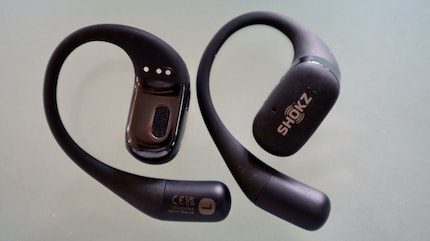
Source: Siri Schubert
Personally, I’m not happy with the fit, despite the good design. The headphones wobble slightly when I’m moving up and down, such as during a sprint or downhill run. This always has me worried that the earphones will fall out and end up on the ground. Although this doesn’t happen while I’m out running, they do come out when I’m putting on a clean shirt.
The headphones only weigh a good eight grammes each according to my kitchen scales, but they’re still not as comfortable to wear as expected. After about an hour, I find the pressure on my ears uncomfortable. It’s only slight, but it still makes me take them off. Of course, this is very subjective and the level of comfort may vary from person to person. I should add that my ears are quite sensitive. Ear buds and in-ear headphones also bother me after a while.
Battery life and charging box
When they’re not in use, the headphones live in a compact charging box that fits neatly into a running belt or backpack. The box also has a quick-charging function. After five minutes of sitting in the box, the small speakers have enough power for an hour of use. Now that’s what I call an effective power nap!
According to the manufacturer, the headphones have enough battery power to last seven hours. With the charging box, they can be recharged several times up to a total of 28 hours in total. This is in line with my experience. The headphones kept going for just under seven hours on a single charge. However, I only listened to music at medium volume and listened to an audiobook for more than two hours. The box indicates the charging status with a green, orange or red light when you open it. If you want to find out more, you can also view the charge level in the app. Charging happens in the box with the USB-A to USB-C cable supplied.
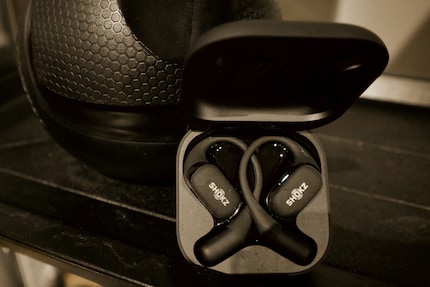
Source: Siri Schubert
The battery has easily managed to last throughout all my runs so far, but the battery life isn’t outstanding compared to other models. The Open Run Pro headphones, for example, have a battery life of around ten hours. In comparison, the Open Fit has significantly less with its seven hours.
Operating requires next-level fine motor skills
Now for the biggest shortcoming of these open-fit headphones in my opinion: operation. «Pause», «Volume» and «Skip» are controlled using the touch function on the parts of the headphone that are at the front of the ear canal. At least in theory – it didn’t work for me straight away. When I bumped into a friend while I was out jogging and wanted to pause the music to have a chat, I tapped the small buttons again and again until the music finally stopped.
Later, I tried the touch controls again, this time to adjust the volume. Again, this didn’t work the first time round. It seems I wasn’t hitting the right spot on the headphones while I was running. I also accidentally paused the music when I pushed my hair back. The music only resumed after several taps.
The commands for the mini touchpads are customisable via the app, so I tried that, too. Double tapping the left earphone should now pause and resume playback. Tapping the right headphone twice should skip to the next track. A single tap on the right should turn the music up and the same gesture on the left should turn it down again.
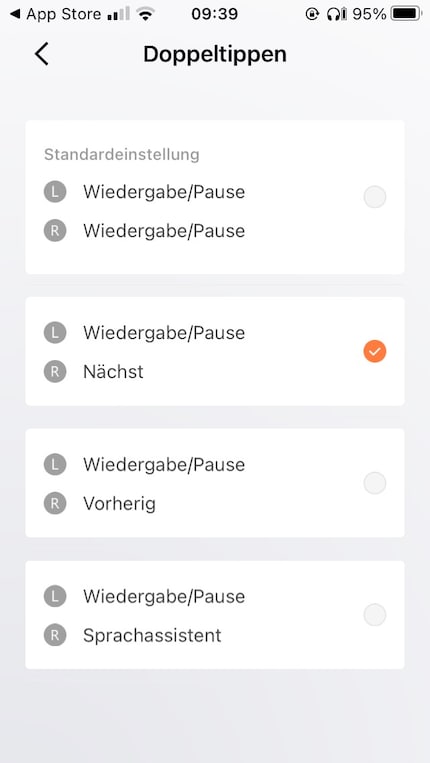
Source: Shokz App

Source: Shokz App
This doesn’t work reliably for me either. Especially during sports, when my moving about makes precise tapping difficult. What’s more, when I wanted to put the loose-fitting headphones back into place, I also unintentionally adjusted the volume or stopped playback completely.
I would have liked the Open Fit headphones to have small, tactile buttons like the Open Run Pro model, which I tested a few months ago. And an off button would’ve been nice. One that would let me switch off the headphones even when they’re not in their case.
Connecting to my iPhone and switching between iPad and iPhone didn’t always work smoothly for me, despite multipoint pairing. On several occasions, I had to disable Bluetooth on my iPad to unpair the device from my headphones before I could listen to music on my iPhone.
Running to the sound of music, birdsong and street noise
My usual running route takes me along country lanes and through a wooded area. With my earphones I can hear the twittering of birds, the murmur of a stream and approaching cyclists clearly enough. I also find the quality of the music and especially the powerful bass surprisingly good for open-ear headphones. The sound’s vibrant, balanced and nuanced. In this point, the Open Fit offer more than the Open Run Pro with their bone conduction technology. However, these types of headphones will never sound as good as models designed purely for audio pleasure. I guess that goes without saying.
At the heart of the mini speakers is what the manufacturer calls DirectPitch technology. Put simply, the sound is channelled in a way that keeps the distance to the ear canal and eardrum as small as possible and the majority of the sound waves are directed in the right direction. This works pretty well, because very little of my music gets out, as several people have confirmed.
In a relatively quiet environment, the concept of open-fit headphones works for me. I enjoy the beats and the audio book as I trot through the countryside. But it’s a different story when I’m running along a busy street. I really have to turn up the volume (not an easy task for me with the touch controls) to hear anything at all. Mixed with street noise and the sound of the rising wind, the listening pleasure’s out the window.
Next, I take the headphones with me to the gym. Again, I’m not impressed. The music from my headphones starts to mix in with the background music and it sounds awful. Things are better with a podcast. In any case, there are better alternatives for the gym, such as noise-cancelling headphones. After all, I want to block out the loud bang of weights hitting the floor and the groans of particularly tough exercisers as much as possible.
Speaking of noise cancelling, the open-fit headphones only feature this function on the microphone. Otherwise the concept of ambient sound perception would make no sense. With the help of artificial intelligence, your voice is filtered when you make a call and ambient noise is suppressed. This worked very well in my case. When I took a test call next to a rushing stream, the caller heard me loud and clear and couldn’t tell where I was.
The app’s useful, but not a must
There are four equaliser modes in the app plus the option to configure your own settings. For my ears, the standard setting and the setting for spoken word for phone calls are sufficient. For podcasts and audiobooks, I prefer the standard. The call setting, on the other hand, sounds a little tinny for this application.
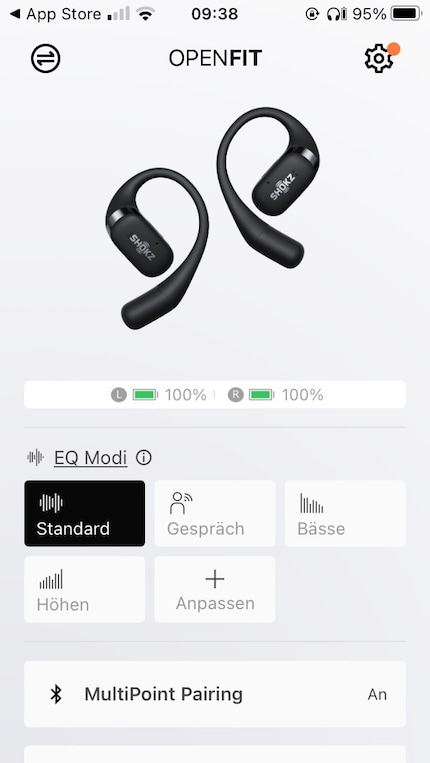
Source: Shokz App
The app (for iOS and Android) is optional. You can use it, but you don’t have to. I like that, because the less complicated things are to get started with a product, the better. And if I do want to customise a certain feature, the app comes into play. In my case, I set the key assignment of the touch controls in a way I found to be the most intuitive.
In a nutshell
Not quite catering for its niche
The longer I use the headphones, the more I think the Open Fit aren’t specifically suited for sports – unlike the Open Run Pro. Why? Because the touchpad’s too small and sensitive for workouts. What’s more, you really need to turn up the volume, which doesn’t make for a very nice audio experience. And the fit isn’t great, either. The IP54 protection, which tells you how dust- and splash-proof the headphones are, is low compared to other sports headphones. This doesn’t exactly scream heavy outdoor use.
For these reasons, I’d say the headphones are more suited for general everyday use. So in which situations do the Open Fit come into their own? In an open-plan office, I’d go for noise-cancelling headphones. In the gym, I prefer earbuds that cancel out background noise but can be switched to transparency mode, which lets in ambient noise. The lack of an on/off switch isn’t great either. Especially when I take the headphones off for a bit without putting them in their box. Why? Because they stay connected and prevent me from taking calls with my iPhone.
Put simply, I fail to see a clear use for the Open Fit. And when it comes to running and other sports, I prefer to stick with the Open Run Pro. They’re a better fit, have easier controls and are less prone to acoustic interference thanks to their bone conduction technology. I get the feeling Shokz went a bit overboard with its claim that these are open-ear sports headphones suitable for everyday use.
Pro
- ambient sound remains audible
- individually configurable via app
- good noise cancellation during phone calls
- solid sound with a strong bass for sports headphones
Contra
- no on/off switch
- loose fit without locking option
- audio drowned out by noisy surroundings
- no clear niche being catered for
- touch controls prone to problems during workouts

Research diver, outdoor guide and SUP instructor – I love being in, on and around water. Lakes, rivers and the ocean are my playgrounds. For a change of perspective, I look at the world from above while trail running or flying drones.

